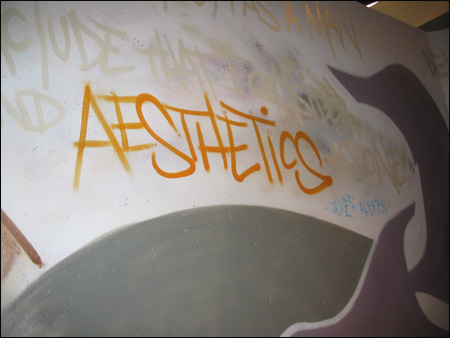
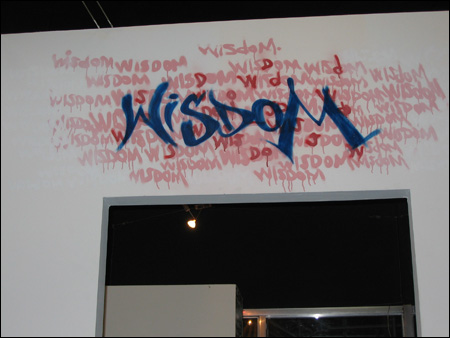



Peace, love, and art theory. Left, above, a fragment from the room-size installation, “sin título,” by Ogral. Right, the words of Exor. The works shown here and below were made in 2006, but the media and dimensions have to be guessed from the context. They are generally wall-size paintings made of acrylic or aerosol spray paint, sometimes with wood and paper.
I stopped into Hato Rey’s Galería Prinardi the other night to attend a conversatorio with the members of SWAT, a group of artists who have thoroughly marked up the gallery walls with their graffiti-derived paintings. I gathered that this is a different style than what Prinardi is accustomed to—by a long shot—since what’s hanging in the back tends toward traditional pintura de caballete from the mid and late twentieth century. Prinardi’s curator, Judith Nieves Lacomba, told me that, in her view, the SWAT installation establishes a kind of “conversation” between those more straight-laced holdings and the works of a new generation. Well, vamos a ver.
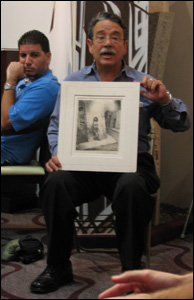
Gallery owner Andrés Marrero started off the evening with a very lengthy and, at times, dizzyingly florid oration about the glories of Puerto Rican art past and present, the island’s eminent graphic traditions, and the role of art generally as the noblest achievement of humankind. He brandished art works and waxed anecdotal about their creators. Here, he holds José Meléndez Contreras’ lithograph, “La esquina del callejón,” from 1941, as SWAT artist Ogral looks on.
I really didn’t mind how over-the-top it was. I have a lot to learn about Puerto Rico, and Marrero’s narration was full of entertaining digressions involving personal encounters with this artist and that one, living and dead, from some of my favorite epochs of twentieth century art. Then too, it all had a point, and the point was to locate the present exhibition, “De acuerdo a la tradición,” squarely within the gallery’s modernist trajectory. Marrero wanted the works of the spray-paint set to “harmonize” with the worthy canvases hanging elsewhere.
So the speech wasn’t exactly aimless, but it clocked in at well over an hour and made my butt hurt. I came to hear from the artists, and their own presentations ended up being modest resumes of their curricula vitae. One by one, Melt, Mero, Jeko, Exor, Ogral, and their associates introduced themselves, and often they mentioned their art school backgrounds in print-making, painting, and so forth. (I understand they prefer to be known by their nombres de calle, and who am I to insist on anything else when a Brazilian artist who goes by the name Assume Vivid Astral Focus gets exhibited all over the world?) The most telling comment among the artists came from Ogral, who cautioned a young listener in the audience that “art should be done for good, not to make money.”
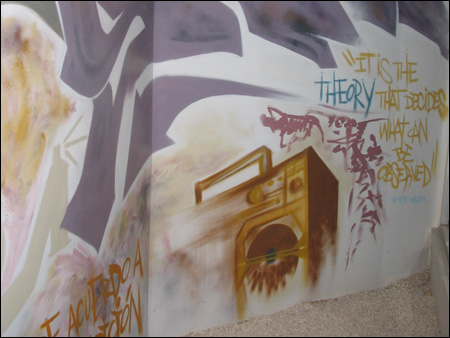
My mind began to wander as Marrero larded it on, and I happened to notice how spotless the rug was. It struck me that whatever “conversation” was going on between old and new in this gallery was awfully soft-spoken. The dealer made much of the fact that he had simply given the artists the gallery key and walked away, as if it was somehow both large-spirited and daring of him. But looking at the results, it seemed like a safe bet. The artists come across as more or less capable technicians, if not exactly brimming with new ideas, and committed to work which has its roots in the streets and the dead of night. In Prinardi’s genteel, nine-to-five confines, the qualities that made this kind of art interesting in the first place are missing: rough edges, screaming colors, nastiness, and most of all, a blaring obviousness, boasting and antagonistic. This latter feature, in particular, seems appropriate, even necessary, for an era in which a timorous populace gets pushed around and browbeaten daily by its pompous, avaricious, disinterested leadership.
When the questions finally started to roll from the audience, one of the best came from Celina Nogueras Cuevas who, in the light of the evening’s torrent of legitimating hyperbole, asked why everyone was so preoccupied with the question of whether or not graffiti is art. It’s a hackneyed question several decades after it first came up, and not very relevant when you think about it, and looking around at the pleasant, thoughtful efforts of the SWAT team, I had to agree.
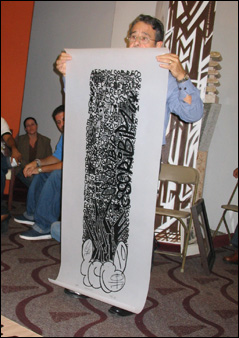
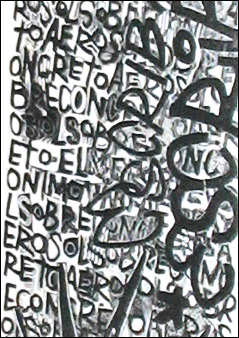
Don’t get me wrong. I liked some of what I saw, and one piece in particular, Mero’s woodcut, “aerosol on concrete”—held by Andrés Marrero above left—actually fulfilled for me the stated imperatives of the show. The artist manages to remain true to a traditional form which had an apogee in Puerto Rico nearly as great as that of Mexico’s Taller de Gráfica Popular, and he makes the subject matter a calligraphy of Homarian density. Yet the print has the unmistakable look of twenty-first century street art. Then there is the Duchampian play of the title: ink on vellum posing as spray-paint on the sidewalk. (Note that the detail above was taken from the photograph on the left which, because of the lighting, gives the print a grey cast. The detail was digitally altered to show the extent to which the work is actually black on white, and may be otherwise distorted.)
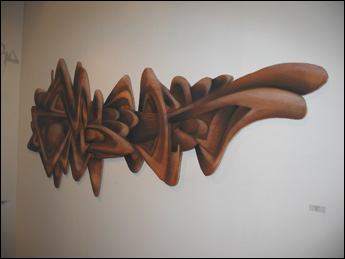
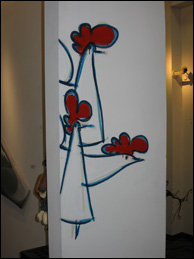
I also liked Exor’s touch with an aerosol can in the piece, “sin título,” above, and the jolly chickens, whose author I was unable to determine, gave the whole exhibition a folky, side street fizz as unexpected and welcome as the Santurce BBQ sign in my nabe.
Galería Prinardi is located in the shopping center at Avenida Muñoz Rivera #500, just off the avenue. It’s a bit of labyrinth to get there, and once in front of the gallery, the parking situation is hair-raising. You might prowl the surrounding neighborhood for a space, but watch out for those “no estacionamiento” signs; they’re enforced. Prinardi’s horario is 10 a.m. to 6 p.m. Monday to Friday and 11 to 4 on Saturday. Phone 787-763-5727 to speak to the helpful staff. They have a comprehensive web-site, www.prinardi.com.
We reached into the bulging Rotund mail sack awhile ago a pulled out this jewel. “Rotund World? You jerks. What’s your statement!” Well, that’s just hilarious. After we passed that one around the office and everyone calmed down, Ernice Delgado over in R&D, wiping her eyes, reminded us that this is not the first time some hapless schmoe wasn’t reading between the lines. We decided then and there that, even though the missive was unsigned—not a promising indication of forthrightness, to be sure—and the tone was not one the writer probably used with mom and dad or Profesora Benítez over at Artes Plásticas, this person was likely of tender years and probably speaking out of ignorance instead of malice. Art world people are so nice, after all. It was a fine chance for Rotund World to fulfill the little-used seventy-third item of its charter, Ernice urged us tartly: to Wise Up the Unwise.
So, here goes nothing, pouty friend. As anyone “in the know” will tell you, aside from the eternal hope of getting laid, art journalism is all about endorsements. If you don’t know what that means, it means names named and money changing hands. Tito! Sylvia! Hey, Michael! Tonio! Pablo! Over here! Pedro! Baby! Who loves ya? (An aside to C----s R. If we don’t get the check tomorrow, the last initial bites the dust, leaving people to wonder, “Which C----s?” We mean it.)
In all honesty, we should explain that Rotund World does not deal only in art world celebrities and mini-celebrities. We have special categories for Art World Wannabes, Art World Has-Beens, and, perhaps of special interest to you, we offer student discounts for lower-case mentions in out-of-the-way places, like our links column or the Tiny Type coda. We will also substitute the caption of a Tiny Type photo depicting an anonymous Viejo San Juan alleyway in the neediest cases.
Beyond that, there is nothing to say. Rotund World hopes to party like it’s 1999. We want to outdo El Vocero at its own game. We yearn to break the world record for the most number of words with the absolute minimum of digestible content—now held by Ilya Schnecken’s 187,483-word line reading of Klaus Barbie’s epic love poetry—but that seems just a lovely, unattainable dream.
A statement! That’s rich. But we love it. Someone, maybe several out in readerland, actually believe that Rotund World should have a purpose. You, dear anonymous letter composer and mutterer of hearty yet shapeless discontents, you are our purpose for now. Read on.